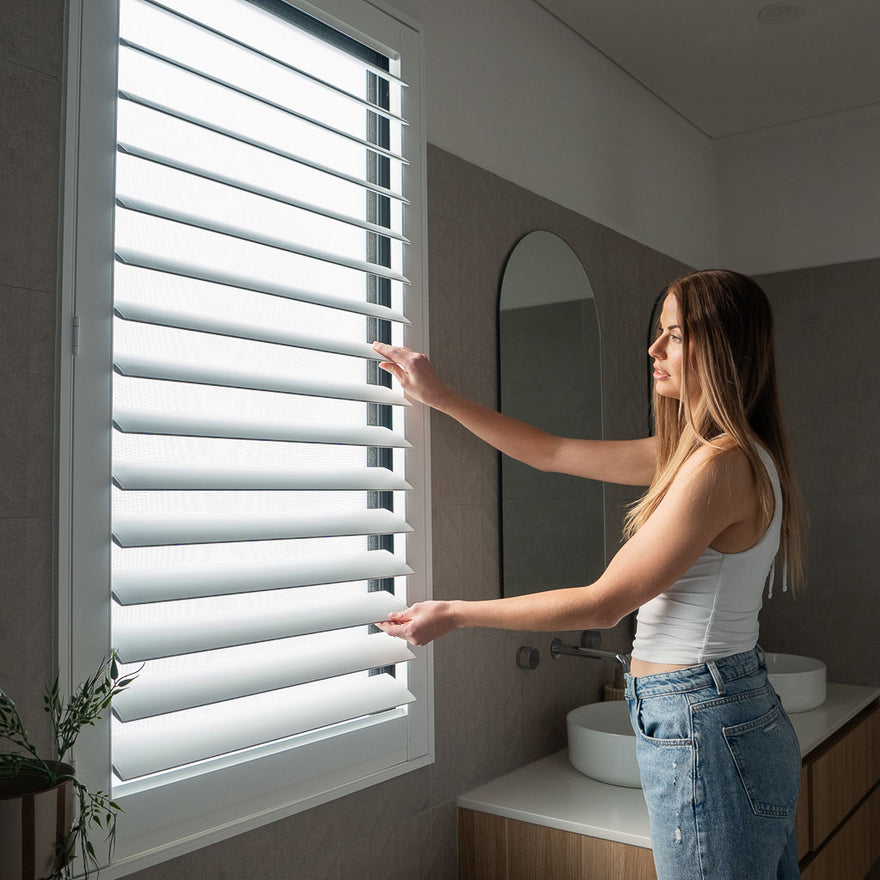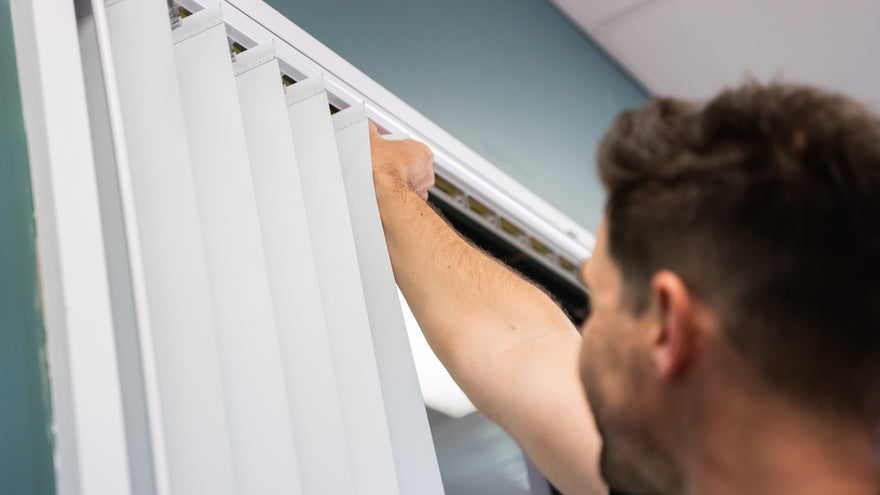1. Assembling your shutter
Please note, these assembly instructions apply to shutters that have been ordered with more than one panel. If a single panel shutter has been ordered, it will be supplied pre-assembled.
1.2. The framing pieces must be assembled first; they will be labelled Top, Bottom, Left and Right. Position all the frames face up on the floor with something soft underneath.
1.3. The frame mitres are joined using Hoffman keys. Place the Hoffman key on a hard surface (a piece of timber is recommended to prevent damage to the floor and to make sure the key finishes flush with the back of the frame) with the rounded end of the key facing up. Push each half of the mitre onto the key, until the mitre joins neatly and flush. Repeat for each corner.
1.4. If the opening requires a T-post, identify the top of the post and position loosely within the frame.
1.5. Place all panels within the frame in their correct order and temporarily insert the hinge pins to ensure all the parts are lined up properly.
1.6. Square up the frame so that all hinge and clearance gaps are even and adjust the position of the T-post so that the panel gaps are even. Attach the top and bottom frame to the T-post using the long screws provided. Pre-drill a pilot hole from the back of the frame to ensure that when you insert the screw to secure the T-post, the screw does not punch a hole through the front surface.
1.7. Remove the hinge pins and panels from the frame before commencing shutter frame installation in the window frame.
2. Installing recess fit Shutter
Depending on the frame type you ordered (Z-frame or L-frame) the process for installing your shutter into the recess will be slightly different:
Z-frames are mounted to the inside of the window frame and wraps around and over the architrave / plaster.
L-frames are mounted to the inside of the window frame and should leave the architrave / plaster visible.
The following instructions are relevant to both Z and L-frame shutters.
2.1 Place the frame into the window recess. For timber window frames, pre-drill holes in the frame rebate behind the top left hinge and the bottom right hinge. Lightly drive screws into the holes, but leave the screw heads out at this stage. This will temporarily hold your frame in the correct position in the window.
2.2. If installing into masonry, drill through the frame, marking the wall inside the recess. Remove the frame and insert wall plugs where marked. Replace the frame and drive in the screws, leaving the heads out at this stage. This will temporarily hold your frame in the correct position in the window.
2.3. Place the left-hand panel into the opening, lining up the hinge sections in the left frame, and then insert the hinge pins. Repeat for all other panels, working from left to right across the opening.
2.4. Assess the panels for squareness to the frame and each other. If gaps are not even or the panels do not line up to each other at the top and bottom, adjustments will need to be made.
2.5. The frame can be adjusted in four directions to square the panels to each other and to the frame. Adjust the four screws as required to make up/down and left/right adjustments.
2.6. Further minor adjustments may need to be made to ensure squareness of panels to the frame. Use methods mentioned in steps 7 – 8 until the panels are square to the frame and the tops and bottoms of the adjacent panels line up. Hinge Spacers can be used to adjust gaps where necessary.
2.7. The remainder of the screws can now be inserted. Generally, a screw should be used wherever there is a hinge on the frame. For the top and bottom frames, a screw should be used wherever there is a striker plate or the closing side of any panel. Additional screws should be placed where necessary, but consideration should be given to the spacing between screws for aesthetic reasons.
2.8. When inserting the screws, if there is a gap between the frame and the recess then a packer (i.e., durable material like plastic or timber) will need to be inserted to ensure the screw does not pull the frame out of square. Additionally, adding hinge spacers between the hinge and frame can help improve the squareness of the shutter to the window.
2.9. Check squareness of all frames and panels again to make sure the panels operate freely.
2.10. Apply caulking around the outside of frame. Where possible, caulking should be the same (or very similar) colour as the recess. This will help make the window opening appear more square.
2.11. Test the function of the panels and if everything is operating smoothly, give them a final wipe down clean before commencing use!
1. Assembling your shutter
1.1. Carefully open the delivery boxes and remove all contents. Then, place the panels in the correct order on the floor, making sure they are the right way up, and any rebates match up.
1.1. The framing pieces must be assembled first; they will be labelled Top, Bottom, Left and Right. Position all the frames face up on the floor with something soft placed underneath.
1.2. The frame mitres are joined using Hoffman Keys. Place the Hoffman Key on a hard surface (a piece of timber is recommended to prevent damage to the floor and to ensure the key finishes flush with the back of the frame) with the rounded end of the key facing up. Push each half of the mitre onto the key, until the mitre joins neatly and flush. Repeat for each corner.
1.4. If the opening requires a T-post, identify the top of the post and position loosely within the frame.
1.5. Place all panels with the frame in their correct order and temporarily insert the hinge pins to ensure all the parts are lined up properly.
1.6. Square up the frame so that all hinge and clearance gaps are even. Adjust the position of the T-post so that the panel gaps are even. Attach the top and bottom frame to the T-post using the long screws provided. Pre-drill a pilot hole from the back of the frame to ensure that when you insert the screw to secure the T-post, the screw does not punch a hole through the front surface.
1.7. Remove the frame cover strips, hinge pins and panels from the frame before commencing installation onto the window frame.
2. Install face fit shutter
2.1. Position the frame evenly around the window opening and lightly drive the first screw into the top left-hand area of the frame but leave the screw head out for now.
2.2. Keep the top of the frame horizontally level using a spirit level (or if architraves are present, the frame should run flush with the top of the architrave) and lightly drill another screw into the top right-hand frame, again, leaving the screw head out a little. This will temporarily hold your frame in the correct place on the window; the rest of the framing will be secured later.
2.3. For wide shutter frames, a screw may also need to be inserted centrally into the top frame to prevent it from sagging.
2.4. If installing into masonry, drill through the frame, marking the wall. Remove the frame and insert wall plugs where marked. Replace the frame and drive in the screws, leaving the heads out at this stage. This will temporarily hold your frame in the correct position.
2.5. Place the left-hand panel into the opening, lining up the hinge sections in the left L-frame, and then insert the hinge pins. Repeat for all other panels, working from left to right across the opening.
2.6. Assess the panels for squareness to the frame and each other. If gaps are not even or the panels do not line up to each other at the top and bottom, adjustments will need to be made using Hinge Spacers or other materials.
2.7. Adjust the bottom frame to the left or right until the gaps are even and the tops and bottoms of the adjacent panels line up. Insert a screw into the bottom of the left frame.
2.8. Re-check that the panels and frame are still square, and the gaps are even by standing back and checking that the whole opening is sitting square on the window.
2.9. Additional screws should be placed where necessary inside the frame cover strip grooves. Consideration should be given to the spacing between screws for aesthetic reasons.
2.9. Additional screws should be placed where necessary inside the frame cover strip grooves. Consideration should be given to the spacing between screws for aesthetic reasons.
2.10. Re-check the squareness of frames and panels and test the function of the panels. If everything is working as intended, carefully press the frame cover strips back into the corresponding grooves of the outward facing frame to cover the screw heads.
2.11. Apply caulking around the outside of the frame. Where possible, caulking should be the same or similar colour as the surface, as it will make the window opening appear square. Where this is not possible, the caulking should be a similar colour to the frame.
2.12. If everything is looking good, give the shutter a final wipe down clean before commencing use!








